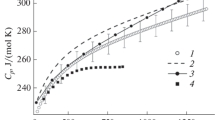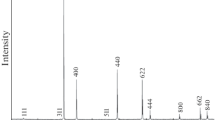Abstract
Differential scanning calorimetry and high-temperature X-ray diffraction were used to measure the molar heat capacity and lattice thermal expansion of pyrochlore europium hafnate in the temperature range 298–1300 K. Eu2Hf2O7 does not experience structural transformations in this temperature range. The thermal expansivities of europium hafnate were estimated.




Similar content being viewed by others
REFERENCES
V. V. Popov and A. P. Menushenkov, Ya. V. Zubavichus, et al., Russ. J. Inorg. Chem. 60, 602 (2015). https://doi.org/10.1134/S0036023615050162
E. R. Andrievskaya, J. Eur. Ceram. Soc. 28, 2363 (2008). https://doi.org/10.1016/jeurceramsoc.2008.01.009
R. W. Scheidecker, D. R. Wilder, and H. Moeller, J. Am. Ceram. Soc. 60, 501 (1977). https://doi.org/10.1111/j.1151-2916.1977.tb14092.x
C. R. Stanek and R. W. Grimes, J. Am. Ceram. Soc. 85, 2139 (2002). https://doi.org/10.1111/j.1151-2916.2002.tb00423.x
M. J. D. Rushton, R. W. Grimes, C. R. Stanek, and S. Owens, J. Mater. Res. 19, 1603 (2004).https://doi.org/10.1557/JMR.2004.0231
R. C. Ewing, W. J. Weber, and J. Lian, J. Appl. Phys. 95, 5949 (2004). https://doi.org/10.1063/1.1707213
H. Yamamura, Solid State Ionics 158, 359 (2003).https://doi.org/10.1016/s0167-2738(02)00874-3
A. V. Shlyakhtina and L. G. Shcherbakova, Solid State Ionics 192, 200 (2011). https://doi.org/10.1016/j.ssi.2010.07.013
X. Q. Cao, R. Vassen, and D. Stoever, J. Eur. Ceram. Soc. 24, 1 (2004). https://doi.org/10.1016/S0955-2219(03)00129-8
G. Mehboob, M.-J. Liu, T. Xu, et al., Ceram. Int. 46, 8497 (2020). https://doi.org/10.1016/j.ceramint.2019.12.200
N. P. Padture, Science 296, 280 (2002).https://doi.org/10.1126/science.1068609
G. Costa, B. J. Harder, V. L. Wiesner, et al., J. Am. Ceram. Soc. 102, 2948 (2019). https://doi.org/10.1111/jace.16113
O. Fabrichnaya and H. J. Seifert, J. Phase Equilib. Diffus. 32, 2 (2010). https://doi.org/10.1007/s11669-010-9815-4
F. A. López-Cota, N. M. Cepeda-Sánchez, J. A. Díaz-Guillén, et al., J. Am. Ceram. Soc. 100, 1994 (2017). https://doi.org/10.1111/jace.14712
R. Kandan, B. P. Reddy, G. Panneerselvan, and U. K. Mudali, J. Therm. Anal. Calorim. 131, 2687 (2018). https://doi.org/10.1007/s10973-017-6802-6
R. Babu and K. Nagarajan, J. Alloys Compd. 265, 137 (1998). https://doi.org/10.1016/s0925-8388(97)00430-1
V. N. Guskov, A. V. Tyurin, A. V. Guskov, et al., Ceram. Int. 46, 12822 (2020). https://doi.org/10.1016/j.ceramint.2020.02.052
P. G. Gagarin, A. V. Guskov, V. N. Guskov, et al., Ceram. Int. 47, 2892 (2021). https://doi.org/10.1016/j.ceramint.2020.09072
M. E. Wieser, Pure Appl. Chem. 78, 2051 (2006). https://doi.org/10.1351/pac200678112051
T. Yu. Kolomiets, G. B. Tel’nova, A. A. Ashmarin, et al., Inorg. Mater. 53, 874 (2017). https://doi.org/10.7868/S0002337X17080152
C. G. Maier and K. K. Kelley, J. Am. Chem. Soc. 54, 3243 (1932). https://doi.org/10.1021/ja01347a029
R. J. M. Konings, O. Beneš, O. A. Kovács, et al., J. Phys. Chem. Ref. Data 43, 013101 (2014). https://doi.org/10.1063/1.4825256
L. B. Pankratz, Bull. U. S., Bur. Mines 672, 188 (1982).
K. V. G. Kutty, S. Rajagopalan, C. K. Mathews, et al., Mater. Res. Bull. 29, 759 (1994). https://doi.org/10.1016/0025-5408(94)90201-1
K. V. G. Kutty, S. Rajagolapan, and R. Asuvathraman, Thermochim. Acta 168, 205 (1990). https://doi.org/10.1016/0040-6031(90)80639-G
ACKNOWLEDGMENTS
This work was carried out using the equipment of the Center for Collective Use of the Kurnakov Institute of General and Inorganic Chemistry of the Russian Academy of Sciences. The assistance of PhD A.A. Ashmarin in HTXRD studies is kindly appreciated.
Funding
This work was supported by the Russian Science Foundation project no. 18-13-00025: https://rscf.ru/project/18-13-00025/
Author information
Authors and Affiliations
Corresponding author
Ethics declarations
The authors declare that they have no known competing financial interests or personal relationships that could have appeared to influence the work reported in this paper.
Additional information
Translated by O. Fedorova
Rights and permissions
About this article
Cite this article
Guskov, A.V., Gagarin, P.G., Guskov, V.N. et al. Thermal Expansion and Thermodynamic Functions of Europium Hafnate at 298–1300 K. Russ. J. Inorg. Chem. 66, 1710–1713 (2021). https://doi.org/10.1134/S0036023621110085
Received:
Revised:
Accepted:
Published:
Issue Date:
DOI: https://doi.org/10.1134/S0036023621110085




